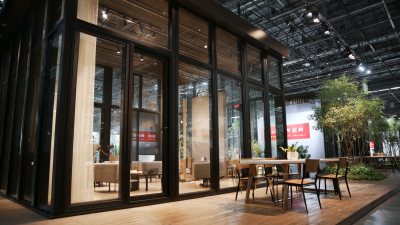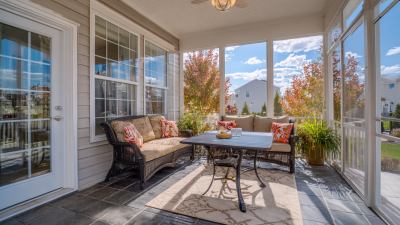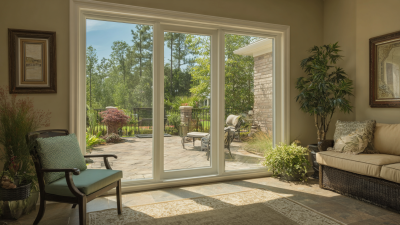Exploring the Best Window Deals for Energy Efficiency and Cost Savings
In today's rapidly evolving energy landscape, finding optimal window deals is more crucial than ever for homeowners looking to enhance energy efficiency and reduce costs. According to the U.S. Department of Energy, windows account for up to 25% of residential heating and cooling costs, making the selection of energy-efficient windows a significant investment. By upgrading to ENERGY STAR® rated windows, homeowners can save an average of $126 to $465 annually on energy bills, depending on the climate and the type of window installed. With the increasing availability of advanced glazing technologies and improved framing materials, the market is rich with innovations that not only provide substantial savings but also elevate home comfort. Whether embarking on a comprehensive renovation or simply replacing a few panes, exploring the best window deals can lead to both immediate financial benefits and long-term sustainability in energy consumption.

Benefits of Energy-Efficient Windows: Savings on Utility Bills and Carbon Footprint Reduction
Energy-efficient windows offer a multitude of benefits that go beyond mere aesthetics. One of the most significant advantages is the potential for substantial savings on utility bills. These windows are designed to minimize heat transfer, which means that during the hot summer months, they keep the cool air conditioned indoors, while in the winter, they help retain warmth. As a result, homeowners can reduce their reliance on heating and cooling systems, leading to lower energy consumption and reduced utility costs over time.

In addition to financial savings, installing energy-efficient windows can significantly reduce one's carbon footprint. By using less energy for heating and cooling, homeowners are contributing to decreased greenhouse gas emissions associated with energy production. This not only promotes a healthier environment but also supports global efforts to combat climate change. The shift towards eco-friendly living can start simply by upgrading to energy-efficient windows, making it a practical step for those looking to live sustainably while enjoying long-term savings.
Current Trends in Window Technology: Innovations for Enhanced Energy Performance
Recent advancements in window technology have significantly enhanced energy performance, addressing the growing demand for energy-efficient home solutions. One of the most notable trends is the integration of smart window systems that can automatically adjust their tint based on sunlight exposure. These dynamic glazing options not only improve comfort by regulating indoor temperature but also reduce reliance on heating and cooling systems, leading to significant cost savings over time.
Another innovation is the development of triple-glazed windows, which offer superior insulation compared to traditional double-glazed windows. By incorporating multiple layers of glass and gas fills, these windows minimize heat loss and prevent outdoor noise from penetrating the home. Additionally, many manufacturers are now utilizing advanced frame materials that provide better thermal insulation, such as fiberglass and vinyl, further contributing to energy efficiency. As homeowners become more environmentally conscious, these cutting-edge technologies are becoming essential components in sustainable building practices.
A Comparative Analysis of Window Materials: Wood, Vinyl, and Fiberglass Efficiency
When it comes to choosing energy-efficient windows, selecting the right material is crucial for maximizing both performance and cost savings.
Wood windows are often praised for their natural insulation properties and aesthetic appeal, making them a popular choice for traditional homes.
However, they require regular maintenance to prevent rot and weather-related damage. On the other hand, vinyl windows are known for their affordability and low maintenance, offering decent thermal efficiency.
They are resistant to moisture and peeling, making them a practical option for many homeowners.
Fiberglass windows are emerging as a superior alternative, combining the best features of both wood and vinyl.
This material provides exceptional insulation and durability, which can lead to significant long-term savings on energy bills—up to 12% on average.
While fiberglass windows typically have a higher upfront cost, their longevity and energy-saving potential make them a smart investment.
As homeowners increasingly prioritize energy efficiency in their renovations, understanding the comparative benefits of these window materials is vital for making informed decisions that enhance comfort and reduce energy costs.
Understanding Window Ratings: How to Interpret Energy Star and U-Factor Data
When exploring window deals for energy efficiency, understanding ratings such as Energy Star and U-Factor is crucial for making informed choices. Energy Star is a certification program that identifies windows which meet strict energy efficiency guidelines set by the U.S. Environmental Protection Agency. Windows with the Energy Star label are designed to reduce energy costs while providing comfort. They are evaluated based on their performance in reducing heat loss and gain, and choosing these windows can lead to significant long-term savings on heating and cooling bills.
The U-Factor, on the other hand, measures the rate of heat transfer through the window. A lower U-Factor indicates better insulation properties, meaning less heat escapes from your home in the winter and less heat enters during the summer. When comparing products, look for windows with a U-Factor of 0.30 or lower, depending on your climate zone. By interpreting these ratings, homeowners can select windows that not only enhance energy efficiency but also contribute to cost savings over time, making them a wise investment for sustainable living.

Cost-Benefit Analysis of Window Replacement: Long-term Gains vs. Initial Investment
When considering window replacement, a cost-benefit analysis is essential to understand the long-term gains versus the initial investment. Homeowners often face a substantial upfront expense when replacing old windows with energy-efficient models. However, the question remains: are these costs justified by the potential savings? Energy-efficient windows can drastically reduce heating and cooling costs, leading to significant savings over time. For many, the return on investment can be realized within 5 to 10 years, depending on local energy prices and climate conditions.
Furthermore, it's important to factor in the added value to the home. Energy-efficient windows not only contribute to lower utility bills but also enhance property value and curb appeal. Buyers often look for homes with modern, efficient features, which means investing in quality windows can yield a profitable return when it comes time to sell. Additionally, the potential for tax credits and rebates may further offset the initial costs, making it a worthwhile financial decision in the long run. Balancing these factors helps homeowners make informed decisions that align with their financial and environmental goals.
Exploring the Best Window Deals for Energy Efficiency and Cost Savings
| Window Type | Initial Cost ($) | Energy Savings per Year ($) | Estimated Lifespan (Years) | Total Savings over Lifespan ($) | Net Gain/Loss ($) |
|---|---|---|---|---|---|
| Double Glazed | 500 | 150 | 20 | 3000 | 2500 |
| Triple Glazed | 800 | 200 | 25 | 5000 | 4200 |
| Low-E Coated | 600 | 180 | 20 | 3600 | 3000 |
| Vinyl Windows | 400 | 120 | 15 | 1800 | 1400 |
Related Posts
-

Innovation in Home Windows Industry at 2025 China Import and Export Fair
-

Exploring Window and Door Replacement Trends at the 138th China Import and Export Fair 2025
-

Maximizing Energy Efficiency: The Impact of Quality Windows and Doors on Home Insulation
-

The Ultimate Guide to Choosing the Best Patio Door Installation for Your Home
-

7 Must Know Tips to Enhance Your Bay Windows Experience
-

Essential Tips for a Smooth Patio Door Installation Experience: Expert Insights Revealed
